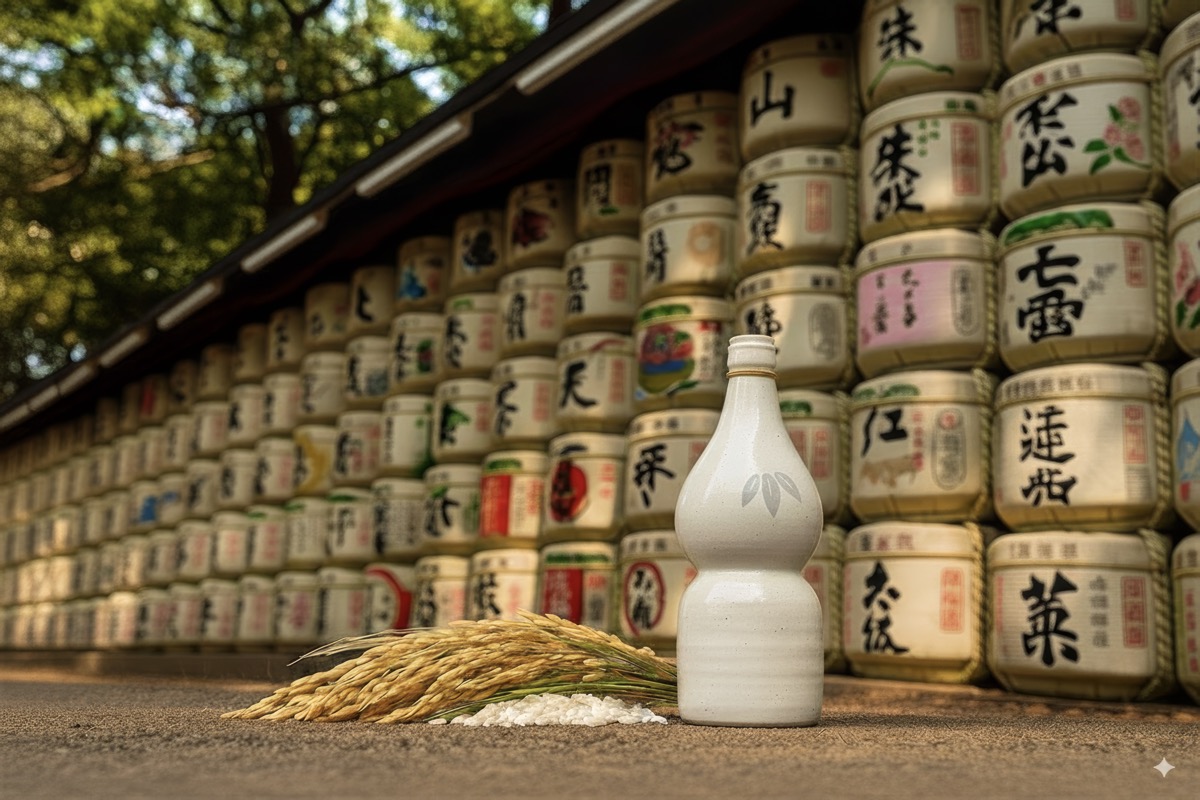Not Just for Sushi : The Global Adventure of Sake
Why are you here, reading this piece? Maybe you already love sake. Maybe you are still figuring out what it is. Either way, welcome.
Not so long ago, the idea of eating raw fish could empty a room in seconds. “Raw fish? You must be kidding,” was the default reaction of many Western diners. A few decades later, sushi is as familiar as pizza or tacos. You can find it in suburban strip malls, at airport kiosks, and in Michelin-starred dining rooms. A glistening slice of tuna no longer shocks anyone.
What changed? Curiosity slowly replaced suspicion. Adventurous eaters led the way. Japanese chefs abroad kept at it with quiet persistence and then dazzling skill, proving that sushi can be both an everyday lunch and a refined art. Japanese food is no longer an exotic curiosity. It is part of the fabric of international dining. Sushi, once shocking, has become comfort food.
Sake tells a different story. Outside Japan, it often remains a mystery, still stuck in the idea that it is simply what you drink with sushi. People picture a tiny cup, sometimes warm and sometimes cold, and that is where the understanding stops.
The truth is far more interesting. Sake has the range and nuance of wine. It can be floral, earthy, crisp, or plush. It can lift oysters with the grace of Champagne, or deepen the richness of roasted meats in a way that recalls Burgundy. It is a world of flavor hiding in plain sight.
So treat it like an adventure. To discover sake is to step into a tradition that spans centuries and is also reinventing itself for the modern table. Take this as an invitation to taste, to ask questions, and to be surprised. The best journeys, in food and in life, begin with curiosity.
The history of sake in Japan
A sacred offering : Third century BCE to eighth century CE
The story begins as early as the third century BCE. Early brewers made kuchikamizake by chewing rice, using saliva to convert starch into sugar, then letting the mash ferment on its own. At first sake was not an everyday drink. It was a sacred offering at rituals and festivals.
By the Nara period, from 710 to 794 CE, brewing became more structured under the ritsuryō state. Sake played an essential role in imperial ceremonies and Buddhist rites.
A Drink of the Aristocracy : Heian period (794 to 1185 CE)
By the eighth century, the imperial court had set up the Sake no Tsukasa, a government bureau devoted to brewing. Heian-era aristocrats favored sweet, dense styles such as shirozake and nerizake. Sake became an elegant indulgence at poetry gatherings and seasonal festivities.
Innovation and wider reach : Kamakura to Muromachi (1185 to 1573 CE)
In the Kamakura period, brewers developed morohaku-zukuri, which used polished rice and abundant kōji. This brought sake much closer to the modern style, improving flavor and quality and enabling larger-scale production.
During the Muromachi years, cities grew and temple breweries expanded. Samurai and wealthy townspeople embraced sake, and the drink moved beyond court circles into broader society.
The people’s drink : Edo period (1603 to 1868 CE)
Edo marked the first golden age of sake. Peace and urbanization under the Tokugawa shogunate drove demand. Brewing centers such as Itami, Nada, and Osaka shipped kudarizake, or downstream sake, to Edo in large volumes. It became a staple and a status symbol.
By the early nineteenth century, Edo drank with conviction. Sake was not just for festivals. It was a weekday habit. Merchants ferried barrels downriver. After work, “just one cup” became its own punctuation mark. Taverns served as bulletin boards and debating halls where regulars traded gossip, cursed their bosses, and argued about sweetness versus dryness. It was not ceremony. It was muscle memory. Pour, sip, talk, repeat.
Then the ground shifted. The shogunate fell and a modern government rose. Breweries had to adapt. New tax codes and grain policies rewired the business. The apprentice system gave way to organized toji guilds. Masters secured rice, controlled supply, and kept books balanced while the state kept a close hand in their pockets. Progress did not arrive politely. Taxes bit and mistakes were costly. Technique sharpened, ambition grew, and a craft industry became a modern one.
The national conversation widened. What counted as good sake was no longer a slogan. It was tested nightly across counters and alleys. Taste reflected its time as well. Before mid-century reforms, Edo sake leaned richer and sweeter than much of what we drink today. Brewers often used less water in the mash, a practice later called ju-mizu, which gave a fuller body and a soft weight where rice and water spoke in a lower register. Dryness rose later. In late Edo, plushness was in charge.
Technical advances such as winter-only brewing, known as kanzukuri, and heat treatment through hi-ire made quality more stable. Sake became widely accessible to common people, served in busy izakaya and teahouses, and woven into festivals and the vibrant culture of the ukiyo, the floating world.
Tradition Meets Modernization : Meiji Era (1868–1912 CE)
Tradition met modernization. Industrial rice-polishing machines allowed finer and more efficient polishing, which led to lighter and more refined styles for an increasingly urban public.
Government labs and universities applied science to brewing. Work on yeast, temperature control, and fermentation stability improved consistency and quality. Brewing moved from pure craft toward an industry informed by research.
The state recognized sake’s economic weight and taxed it heavily. By the late nineteenth century, those taxes made up a large share of public revenue. In the growing cities of Tokyo and Osaka, izakaya served sake with both traditional dishes and new Western foods. Drinking became part of modern urban life while still tied to custom and ritual. Weddings, New Year’s, and local festivals kept sake at the center of community life.
Sake in the Taishō Era (1912 to 1926)
Social change quickened. Democracy, urban culture, and new ideas flourished. Brewing technology advanced again. Modern polishers allowed refinements once unthinkable. Government and university labs promoted scientific approaches to yeast, fermentation, and storage. Cleaner, more stable, and more consistent sake reached a hygiene-conscious middle class. Mass media celebrated sake in literature, advertising, and songs. Drinking it in an izakaya or at a political gathering signaled participation in a more open society.
Shōwa before the war (1926 to 1945)
The national mood darkened. Political turmoil and militarization grew. Rice shortages loomed and the state tightened control. Brewers were pushed to stretch resources. Sanbai-zojōshu, or triple-brew sake, added distilled alcohol and alternative starches to supplement rice. Supply held up, but the drink changed in character and became lighter and less nuanced.
Even so, sake stayed present. Soldiers took a farewell cup before leaving. Families marked seasons and life events with small pours, even in scarcity. As the Pacific War intensified, sake became a tightly controlled commodity. It was diluted, rationed, and adapted for survival, yet it still carried comfort and memory.
Shōwa after the war (1945 to the 1970s)
Postwar Japan began in ruins. Brewing was restricted and many producers relied on diluted, fortified styles to stretch rice. Quality suffered, but the presence of sake offered continuity.
Recovery in the 1950s brought better harvests and more stable breweries. Advances in refrigeration, storage, and yeast returned refinement to prewar levels. By the 1960s, amid rapid economic growth, sake resumed its place in social life. Factories and offices marked milestones with bottles. Weddings and festivals flowed with it. Salarymen drank it in crowded izakaya, often alongside beer.
Large brewers dominated with mass production, while regional makers preserved local styles. This balance of scale and heritage set the stage for a later renaissance.
Sake in the modern age (From the 1970s to today)
By the 1970s, Japan had completed its rapid recovery and entered prosperity. Daily life changed with new consumer goods, technology, and global cultural exchange. Sake stood at a crossroads.
Premium ginjō and regional jizake took off. Small breweries produced distinctive styles that contrasted with big-brand sake. Careful polishing and specialized yeasts brought elegant aromas and flavors that appealed to a new generation. Per-capita consumption reached a historic peak in 1973.
Change soon followed. Beer became cheaper and big brewers won younger drinkers with aggressive marketing. In the early 1980s, sweet, low-alcohol ready-to-drink beverages grew, along with cocktails and imported wine. Sake’s image narrowed to that of an older man’s drink.
The 1990s brought recession and struggle. Many small breweries closed. Domestic consumption fell. Reinvention followed. Inspired by global dining, forward-looking makers chose quality over volume and focused on junmai daiginjō and other premium styles. Sake was repositioned as a refined partner for diverse cuisines.
In the 2000s and 2010s, sake found new life abroad. As Japanese cuisine earned global acclaim, sake appeared on menus from New York to Paris. Sommeliers explored its versatility with oysters, foie gras, and cheeses as well as with traditional Japanese dishes. Specialized boutiques opened in world capitals. International competitions helped set new standards.
A milestone arrived in 2023 when UNESCO recognized sake as intangible cultural heritage. The accolade raised it from national tradition to shared cultural treasure. At the same time, exporters and brewers looked overseas to counter Japan’s aging and shrinking population.
Today, sake is not confined to sushi counters. It stands beside wine in Michelin-starred rooms, appears in tasting flights, and travels well as a gift. Brewers explore terroir by highlighting rice varieties, water sources, and yeast strains with the same precision we expect in wine. Collaborations, including sparkling styles and projects using French-grown rice, show how tradition and innovation can thrive together.
From the exuberance of the 1970s to the trials of recession, from a misunderstood old man’s drink to a global luxury, the journey of sake mirrors modern Japan. It is a story of resilience, adaptation, and reinvention. Its spectrum of flavor now speaks to Japanese identity and to the imagination of chefs and drinkers everywhere.
Sake and the changing drinks landscape
The twentieth century brought turbulence. Wartime scarcity made triple-brew sake common, fortified with extra alcohol and alternative starches. Beer was still a luxury and could cost nearly half a day’s wages for a single large bottle, so sake remained the everyday choice.
The 1970s brought another peak with ginjō and jizake spreading nationwide. In 1973, per-capita consumption reached an all-time high. Then beer fell in price, advertising grew louder, and sweet low-alcohol drinks like Suntory Horoyoi found a following in the early 1980s. Cocktails and wine took off in the cities and sake’s image aged.
Reinvention for a global table
Younger generations drank less and the population aged. Domestic sales fell. Abroad, a different picture appeared. As Japanese cuisine gained prestige in the twenty-first century, sake stepped onto new stages. Exports rose and UNESCO recognition in 2023 confirmed its cultural value.
Now sake is at home well beyond sushi bars. It sits comfortably next to wine in fine restaurants, pairing with French classics and modern haute cuisine in ways that surprise even experienced sommeliers. The precision and care behind its making, often in family breweries that have endured for centuries, make it equally suited to a gift box and to a complex tasting menu.
What began as a sacred offering and later became a humble daily drink has reemerged as a global luxury. Its range of styles is ready for the imagination of chefs and for the curiosity of drinkers everywhere.
Sake’s rise has been astonishing. I always liked it, but I did not fall in love until I moved to France. In Japan my ritual was simple. I went to a soba shop, ordered itawasa—fish cake with wasabi—and drank whatever was poured. I did not ask about the brand. No one did. If you wanted it cool you said hiya. If you wanted it hot you said atsukan. That was the range of choice.
Back then, asking about labels felt like showing off. Even now I do not obsess over whether the bottle says junmai daiginjo or daiginjo. On paper the difference is clear, one has no added alcohol and the other does. The glass does not always follow the script. Sometimes the plainest junmai carries the house’s voice best, steady and unmistakable.
What I love most is the experiment. Same brewery, same rice, different polish. That is when the picture comes into focus. One bottle tastes like lilies and white peaches. Another stays quiet and cool, grain-pure, with a hum of umami that pulls the food closer. Neither is better. Polish simply rearranges the furniture. Take a few percentage points off the rice and the whole room changes, the smell, the light, even the way you talk.
The easiest way to learn your own style is to start with Dassai. They make it clear, same label, different polishing levels. Line them up and pour them side by side. You will know quickly how much polish feels right for you. After that, choosing bottles from other breweries becomes far less intimidating.


